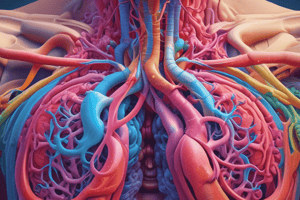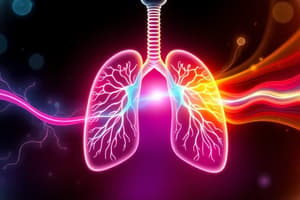Podcast
Questions and Answers
Where does cellular respiration primarily take place in eukaryotic cells?
Where does cellular respiration primarily take place in eukaryotic cells?
- Lysosome
- Endoplasmic Reticulum
- Nucleus
- Mitochondria (correct)
Which of the following is NOT one of the three main stages of cellular respiration?
Which of the following is NOT one of the three main stages of cellular respiration?
- Photosynthesis (correct)
- Glycolysis
- Electron Transport Chain
- Citric Acid Cycle
What is the main purpose of the Citric Acid Cycle in cellular respiration?
What is the main purpose of the Citric Acid Cycle in cellular respiration?
- Generate NADH and FADH2
- Generate ATP and NADH
- Produce Pyruvate
- Release CO2 (correct)
During cellular respiration, where does the Electron Transport Chain take place?
During cellular respiration, where does the Electron Transport Chain take place?
What is the energy currency of cells that is produced during respiration?
What is the energy currency of cells that is produced during respiration?
Which stage of cellular respiration directly generates ATP within the cytoplasm?
Which stage of cellular respiration directly generates ATP within the cytoplasm?
What is the primary function of gas exchange in organisms?
What is the primary function of gas exchange in organisms?
How does temperature generally affect respiration rates?
How does temperature generally affect respiration rates?
What happens to respiration rates as pH levels become more acidic?
What happens to respiration rates as pH levels become more acidic?
What are the consequences of untreated respiratory failure?
What are the consequences of untreated respiratory failure?
Where does the exchange of gases between the air and bloodstream primarily occur in humans?
Where does the exchange of gases between the air and bloodstream primarily occur in humans?
How does a decrease in oxygen concentration affect respiration rates?
How does a decrease in oxygen concentration affect respiration rates?
Flashcards are hidden until you start studying
Study Notes
Life's Essential Processes: Exploring Respiration
Life is filled with a dazzling array of processes that enable organisms to survive and thrive. Among the most fundamental of these processes is respiration, a central aspect of life that allows us to sustain ourselves and convert the energy stored in food into the energy we need.
Respiration: A Definition
Respiration is simply the process by which living organisms obtain energy by breaking down organic molecules. In this process, chemical energy is transformed into adenosine triphosphate (ATP), the energy currency of cells. For multicellular organisms, respiration occurs in two stages: cellular respiration within cells and gas exchange between organisms and their environment.
Cellular Respiration
Cellular respiration is a series of complex biochemical reactions that break down organic molecules, primarily glucose, and release energy. The process takes place in the mitochondria, the powerhouses of cells. There are three main stages of cellular respiration:
- Glycolysis: Occurs in the cytoplasm and generates ATP, as well as two molecules of pyruvate.
- Citric Acid Cycle (also known as the Krebs cycle or TCA cycle): Occurs in the mitochondrial matrix and generates ATP, as well as NADH, FADH2, and CO2.
- Electron Transport Chain (ETC) and Oxidative Phosphorylation: Occurs in the inner mitochondrial membrane and generates ATP, along with the release of energy in the form of heat.
Gas Exchange: Respiration and the Lungs
Gas exchange occurs between organisms and their environment, allowing organisms to replace oxygen used in cellular respiration with fresh oxygen, while also removing carbon dioxide, a waste product of cellular respiration. In humans, this process takes place in the lungs. The lungs, through a series of branching tubes and sacs, facilitate the exchange of gases between the air and bloodstream.
Oxygen, which is essential for cellular respiration, diffuses from the air into the bloodstream. Carbon dioxide, a waste product of cellular respiration, diffuses from the bloodstream into the air. This exchange is aided by the movement of air in and out of the lungs through the process of respiration.
Factors Affecting Respiration
Respiration is influenced by various factors, including:
- Oxygen concentration: Respiration rates increase as oxygen concentration decreases, and vice versa.
- Temperature: Respiration rates generally increase with temperature, but can decrease if temperatures become too high.
- pH: Respiration rates decrease as pH levels decrease (become more acidic) and increase as pH levels increase (become more alkaline).
Consequences of Respiratory Failure
Respiratory failure is a critical condition in which the body is unable to obtain sufficient oxygen or eliminate carbon dioxide effectively. This can result from a variety of causes, such as respiratory diseases, blockages, or injuries. If left untreated, respiratory failure can lead to serious complications, including brain damage, tissue death, and heart failure.
Conclusion
Respiration is a fundamental process that underpins life. It enables us to generate the energy we need to survive and thrive, while also facilitating the exchange of gases between organisms and their environment. Understanding the intricacies of respiration is essential for grasping the complexities of life and the processes that bring it to life. By acknowledging the essential role of respiration and exploring its subtleties, we delve deeper into the mysteries and wonders of life itself.
Studying That Suits You
Use AI to generate personalized quizzes and flashcards to suit your learning preferences.




